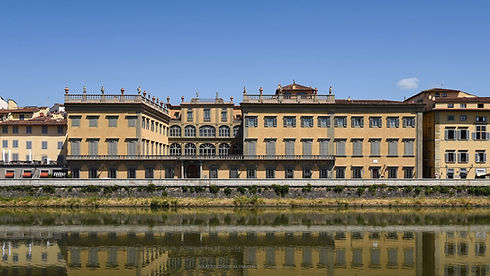FG FINE ART LTD


For his first participation in the Florence Biennale, Flavio Gianassi presents an exceptional selection of paintings and sculptures, ranging from the 14th to the 17th century.
A fascinating portable triptych, made for private devotion, is undoubtedly among the qualitatively highest works of the corpus attributed to the anonymous artist from Prato known as the Master of Mezzana (active in Prato between 1320 and 1340). The tabernacle, depicting the Madonna and Child between Saints Louis of Toulouse and Francis; Crucifixion under the Angel of the Annunciation; Madonna of Mercy under the Virgin Annunciate, in recent years was owned by the well-known Florentine antiquarian and collector Carlo De Carlo and we can most likely date it towards the end of the second decade of the 14th century, in the first phase of the artist's career.
Declared of exceptional historical and artistic interest in 2019, Gian Lorenzo Bernini’s Four Screaming Heads in gilded bronze, also known as mascheroni, are certainly among the highlights of the presentation.
Exhibited at the Victoria and Albert Museum in London (1962), the Rijksmuseum in Amsterdam (1962 and 2019) and the Kunsthistorisches Museum in Vienna (2019), the works, which had however only been visible in Italy in 1962 at Palazzo Strozzi on the occasion of the exhibition Italian Renaissance Bronzes, return to Florence for the Biennale. The small sculptures constitute an important historical and artistic document, having already been remembered in the antechamber of the noble apartment of Bernini's palace in Rome, in via delle Mercede near the church of Sant'Andrea delle Fratte. The bronzes, which have remained in the family of Bernini's heirs to this day, are part of the surviving nucleus of the artist's legacy, which included works made by himself and by other artists he collected. The four heads are in fact already mentioned in the inventory of his assets of 1681, where they are recorded as "four small heads of cast bronze, with their stone feet, which were the vases of the carriage described". These precious sculptures were created by Gian Lorenzo Bernini as eccentric decorations for his personal carriage. The Four Screaming Grotesque Heads bring back into a decorative function the figurative invention that Bernini had created, with solemn drama, in the famous marble sculpture of the Damned Soul.
Practical info
Opening Hours
27 September by invitation only
28 September - 6 October
Every day 10.30am -8.00pm
Location
Palazzo Corsini
Lungarno Corsini
Firenze








